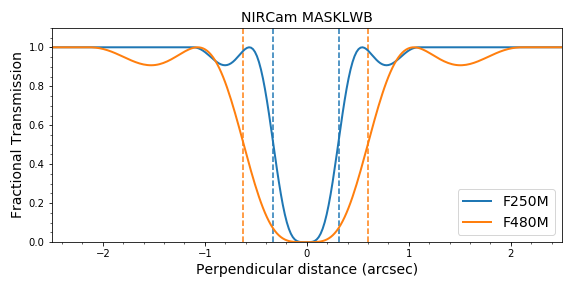NIRCam Coronagraphic Occulting Masks and Lyot Stops
NIRCam coronagraphy offers 3 round and 2 tapered bar occulting masks paired with apodizing Lyot stops that allow high-contrast imaging with nominal inner working angles (IWAs) ranging from 0.23" to 0.61".
On this page
When centered on a bright point source, an occulting mask blocks the core of the point spread function (PSF). Diffracted light in the wings of the PSF is apodized by a Lyot stop in the pupil plane. Together, the occulting mask and Lyot stop constitute a "Lyot coronagraph," which enables high-contrast imaging (HCI) of faint features near bright point sources.
Occulting masks
NIRCam's occulting masks are binary half-tone patterns composed of 2–4.3 μm squares that approximate greyscale transmission masks. They are lithographically etched from a chrome-on-aluminum coating deposited atop a multilayer, anti-reflection (AR) coated sapphire substrate that is the basis of the coronagraph optical mount (COM). Also located along the edges of the COM substrate are 5″ × 5″ and 2.5″ × 2.5″ squares of nichrome with an optical density of ~3, the larger set of which serve as neutral density (ND) filters for bright target acquisition (Figure 1). The transmission profiles of the 5 occulting masks are shown in Figure 2; the transmission of the COM substrate is shown in Figure 1 of NIRCam Filters for Coronagraphy.
Lyot stops
The Lyot stops are metallic patterns deposited photolithographically onto wedge-shaped Si and BaF2 substrates located in the pupil wheels of the LW and SW channels, respectively. Each channel has 2 Lyot stops designed to suppressed diffracted light from the round and bar occulters (Figure 3). When inserted into the optical train, the wedges shift the optical path so that the COM is projected onto the detector arrays (Figure 1 of NIRCam Coronagraphic Imaging).
The transmission of the Si substrate is > 95%–98% between 3 and 5 µm. The transmission of the BaF2 substrate is more chromatic: ~95% at 1 µm, ~75% at 2.5 µm, and ~80% for most of the coronagraphic filters. Each Lyot stop has a throughput of ~20%, so the combined loss of light from the coronagraphic optics at distances > 1″ from the centers of the occulters is ~86-90%. The JWST Exposure Time Calculator (ETC) provides a "total system throughput" plot for any coronagraphic configuration.
Focal plane images
Figure 4 shows actual images of direct and coronagraphic coronagraphic point spread functions (PSFs) obtained during JWST Commissioning (Program 1441), using the MASK335R and MASKLWB occulters and their corresponding Lyot stops. The coronagraphic PSFs (right panels) reflect the Fourier transforms of the Lyot stops.
References
Girard, J. H., et al. 2022, Proceedings of the SPIE, 121803Q
JWST/NIRCam Coronagraphy: commissioning and first on-sky results
Krist, J., et al., 2010, SPIE, 7731,3J
The JWST/NIRCam coronagraph flight occulters
Mao, Y., et al., 2011, SPIE, 81500E
NIRCam coronagraphic Lyot stop: design, fabrication, and testing





